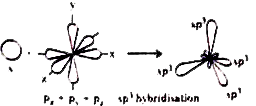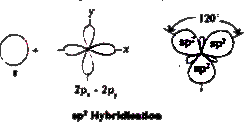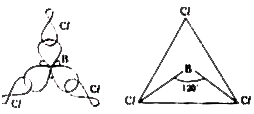What do you understand by Hybridisation ? Explain different types of hybridisation involving s and p orbitals. Solution in Telugu
Hybridisation : "intermixing of atomic orbitals of almost equal energies of an atom and their redistribution into an equal number of identical orbitals is called, 'hybridisation'.
Examples : Let us see the three types of hybridisations - sp3,sp2 and sp.
1) sp3 Hybridisation : The phenomenon of intermixing of one 's' orbital and three 'p' orbitals forming four 'sp3' hybrid orbitals is called sp3 hybirdisation.
Each of the sp3 hybrid orbitals possess 14 of s - character and 34 of p character. The bond angle in-betweeen any two sp3 hybrid orbitals is 109∘28'. The shape of the molecule in which the central atom undergoes sp3 hybridisaition is tetrahedral.

Example : Formation of Methane (CH4) molecule :
In the formation of methane molecule the central carbon atom undergoes sp3 hybridisation in its excited state. As a result of which four sp3 hybrid orbitals will form on it. All the four sp3 hybrid orbitals possess bond pair of electrons. Now, the four sp3 hybrid orbitals overlap head - head with '1s' orbitals of four 'H' atoms forming CH4 molecule. The shape of the molecule is tetrahedral with a bond angle of 109∘28'.
C(Z) = 6 1s22s22p2
Ground state 1s22s22p12p1
Excited state 1s22s12p1x2p1y2p1zsp3

2) sp2 Hybridisation : The phenomenon of intermixing of one 's' orbital and two 'p' orbitals forming three 'sp2' hybrid orbitals is called sp2 hybridisation.
Each of the sp2 hybrid orbitals possesses 13 s - character and 23 p - character. The bond angle in between any two sp2 hybrid orbitals is 120∘. The shape of the molecule in which the central atom undergoes sp2 hybridisation is plane triangular.

Example : Formation of Boron trichloride (BCl3) molecule :
In the formation of BCl3 molecule the central boron atom undergoes sp2 hybridisation in its excited state (1s22s12p1x2p1y2p0z). As a result of which three sp2 hybrid orbitals will form on it. All the three hybrid orbitals possess an electron each. Now, the three sp2 hybrid orbitals overlap head - head with half - filled '3pz orbitals of three chlorine atoms forming BCl3 molecule. The shape of the molecule is plane triangular with a bond angle of 120∘.

3) sp Hybridisation : The phenomenon of intermixing of one 's' orbital and one 'p' orbital of an atom forming two 'sp' hybrid orbitals is called sp hybridisation.
Each of the sp hybrid orbitals possesses 12 s - character and 12 p - character. The bond angle in-between the two hybrid orbitals is 180∘. The shape of the molecule in which the central atom undergoes sp hybridisation is linear.

Example : Formation of Beryllium chloride (BeCl2) :
In the formation of BeCl2 molecule the central 'Be' atom undergoes sp hybridisation in its excited state (1s22s12p1x2p0y2p0z). As a result of which two sp hybrid orbitals will form on it. The two hybrid orbitals contain an electron, each. Now, the two sp hybrid orbitals overlap head - head with half - filled '3pz' orbitals of two chlorine atoms forming BeCl2 molecule. The shape of the molecule is linear with a bond angle is 180∘.

Topper's Solved these Questions
- BOOK - VGS PUBLICATION-BRILLIANTCHAPTER - CHEMICAL BONDING AND MOLECULAR STRUCTUREEXERCISE - SHORT ANSWER QUESTIONS33videos
CHEMICAL BONDING AND MOLECULAR STRUCTURE
- BOOK - VGS PUBLICATION-BRILLIANTCHAPTER - ATOMIC STRUCTUREEXERCISE - ADDITIONAL QUESTIONS & ANSWERS22videos
ATOMIC STRUCTURE
- BOOK - VGS PUBLICATION-BRILLIANTCHAPTER - CHEMICAL EQUILIBRIUM AND ACIDS-BASESEXERCISE - ADDITIONAL QUESTIONS & ANSWERS8videos
CHEMICAL EQUILIBRIUM AND ACIDS-BASES
Similar Questions
Write the general properties of Ionic Compounds.
05:33View SolutionCalculate the number of protons , neutrons and electrons in .8035Br
03:13View SolutionPCl5,PCl3 and Cl2 are at equilibrium at 500K and having concentration 1.59MPCl3,1.59MCL2 and 1.41MPCl5. Calculate Kc for the reaction PCl5⇔PCl3+Cl2
02:44View Solutionऑर्बिटलो के अतिव्यापन से आप क्या समझते है ? s तथा p -ऑर्बिटलों के अतिव्यापन को स्पष्ट कीजिए । सिग्मा तथा पाई -आबन्ध क्या है तथा इसके मध्य मुख्य अन्तर क्या है ?
05:20View Solutionएकसंकर ( मोनोहाईब्रिड ) तथा द्विसंकर ( डाइहाइब्रिड ) संकरण से आप क्या समझते है ?
02:44View SolutionWhen one s and three p orbitals hybridise,
View Solution[NiCl4]2− is an outer orbital complex. Give:
(1) the type of hybridisation in Ni2+
(2) the orbitals involved in hybridisation.06:38View SolutionWhen one s and three p orbitals hybridise,
02:43View SolutionWhen one s and three p orbitals hybridise,
00:35View SolutionIn order to explain the characteristic geometrical shapes of polyatomic molecules, Pauling introduced the concept of hybridisation. The orbitals undergoing hybridisation should have nearly same energy. There are various types of hybridisations involving s, p and d - type of orbitals. The type of hybridisation gives the characteristic shape of the molecular or ion. Which molecule does not have the same type of hybridisation as P has in PF_(5) ?
00:35View SolutionWhat type of hybridisation of carbon is involved in benzene?
02:03View SolutionHybridisation of one s and one p orbitals form
03:16View SolutionHybridisation of one s and one p orbitals form
07:54View SolutionWhat type of orbital hybridisation is considered on P in PCl5 ?
09:55View SolutionThe type of d-orbital involved in sp3d hybridisation is
01:43View Solution

